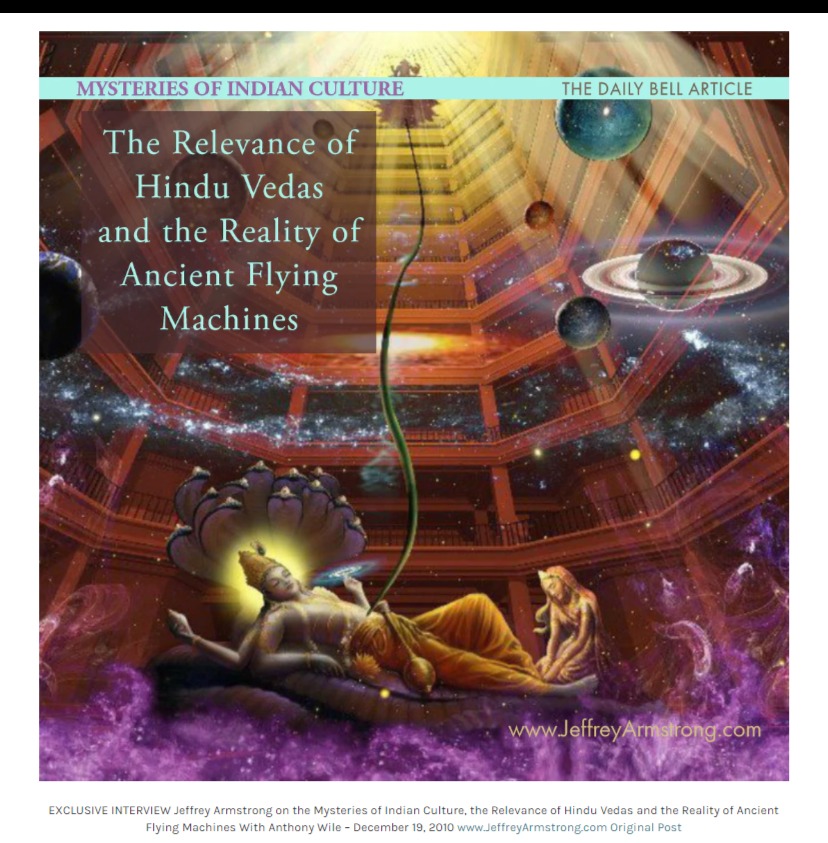by Jeffrey Armstrong
Introduction: Jeffrey Armstrong is an award-winning author of numerous books on Vedic knowledge including his recent book: Spiritual Teachings of the Avatar, Ancient Wisdom for a New World. He is a philosopher, practitioner and teacher of the Vedas for the past 40 years. He has degrees in Psychology, History & Comparative Religions, and Literature and had a successful career as an executive in Silicon Valley before turning to teaching full time. Jeffrey Armstrong (Kavindra Rishi) is the founder of VASA – Vedic Academy of Sciences & Arts in Vancouver Canada. His work aims at promoting higher education in the Vedic sciences, showing their roots in Veda and Vedanta, taking an integrated approach with the different Vedic disciplines. As the Vice President and International Media Coordinator for the Vedic Friends Association (VFA), Jeffrey Armstrong is a global advocate for the Sanatana Dharma Culture.
Daily Bell: Give us some background. Where did you grow up?
Jeffrey Armstrong: I am one of those people that people often ask: How did you do all that in one life? I was born in Detroit, Michigan and by the time I was 13 I had become more interested than anyone I knew in questions such as: Who are we? Why are we here? What is life? I was a philosopher in the making, but I sure wasn’t surrounded by many others in the suburbs of Detroit. Eventually, everything I did became directed toward answering these questions.
Daily Bell: Did you focus on these issues in college?
Jeffrey Armstrong: I went off to university and spent five years working on a double major, one in psychology and one in creative writing, literature, and poetry. During that time – which was also the 60s – I was intensely involved in social developments and what was going on in the world and the experiences of the time. From that I was led, in almost every subject that I entered into, toward India. It is my opinion that if one studies most any modern subject with real diligence, they will be led, as I was, to India. India has the largest simultaneously scientific and spiritual ‘library’ known to exist.
I then spent five years in a Yoga ashram, as a celibate monk, being trained in the knowledge and practices of India. At the end of that time I spent two years learning Vedic Astrology. In the west, Astrology is mostly considered entertainment but in India it is a very serious and rigorous science. Then I went back for another degree in History and Comparative Religion where I spent 3 more years and then a year of graduate work in South Asian studies at the University of Wisconsin. I also studied modern dance, various forms of martial arts, fencing, Chinese herbal studies and rode and trained horses for many years.
Starting in 1980 I began working in corporations in Silicon Valley. I first worked for Apple Computer as their Middle Eastern Sales Manager and then spent the next 7 years at the heart of the explosion of Silicon Valley, in various Executive Sales & Marketing positions. Finally, I decided I would prefer to work outside the corporation, as a consultant, rather than inside. So, I built a career for myself as a corporate motivational speaker and spent the next 10 years speaking to Fortune 500 companies around the world. That was my work until 14 years ago, when I made the commitment to be a full time spiritual teacher. During all these years, I have been an avid Mystical poet and have written over 1,600 poems describing the philosophy of India in modern English.
Daily Bell: How did you get interested in Indian culture and religion?
Jeffrey Armstrong: Religion is the wrong word to use for India’s teachings. Religion is a word that is more accurately applied to the Middle Eastern Abrahamic cultures. Judaism, Christianity and Islam are religions. The origin of the word religion, from the Latin, is re-legare (a legalistic system of rules given by God) or ‘bound by rules.’ Re = tied up or connected by, and ligion = legare = ligaments = to tie, bind or bandage. The usual idea is that the practitioner of a religion is bound up in rules or laws. This especially applies to the three Abrahamic religions of Judaism, Christianity and Islam, whereas the spiritual practices of India are called a Dharma Culture. The main difference is religions generally have one book of rules and stories whereas a Dharma culture has a library of spiritual and material knowledge aimed at understanding who we really are and how to properly use everything around us. The phrase Dharma Culture is a more accurate descriptor for India, as compared to the ‘Indian religion’ or ‘Hindu religion.’
At the core of the Abrahamic Religions is a set of rules given by God that we are told we must follow because a specific vision of God and His prophet said so. That is not the basis of the Vedic Spiritual Library of India. India does not have a single book or an authoritarian/disciplinarian God, it uses an entirely different approach to the question of who we are and it is certainly more philosophical than a Religion, but it also contains many other components. It has a library of self-actualizing sacred knowledge, rather than just one dogmatic book.
Daily Bell: What do you believe in and why? What application does it have to the West?
Jeffrey Armstrong: My lifelong effort has been to try to find things that are universally true rather than relatively true and I believe that the largest library of that information exists in India in spite of the fact that India is a very fragmented culture right now due in large part to 1200 years of violent colonization by outside invading forces. This library of knowledge stretches back for thousands and thousands of years and is, as far as I know, the largest repository of the universal truth that exists on our planet.
What we now call the West is the outgrowth of a tribal or city/state approach to living on the planet. This means if you take care of your tribe, you are seen as good. So, to all those tribes who were fighting against each other for thousands of years in a series of wars, that essentially meant that as long as the spoils of the wars were brought back and shared amongst the tribe, they were good. Alexander the Great was a prime example of this. He went out to rape, pillage and conquer, and was a monster to the rest of the world, but was considered great by his people, hence the name. He was really great at being a warmonger, and a rapist and a pillager. But he brought his people back the spoils of war. India, on the other hand, is the only culture of its size in the world that has never gone out and tried to spread its beliefs by war. In fact, it has consistently given shelter to anyone from any culture. So, to compare histories, the west is a competitive, war-based civilization and India has been a nurturing, cooperation-based civilization on an epic scale. I am involved in the process of practicing and transferring that cooperative culture of India to the war-based culture of the west at a crucial time when it is needed very much.
The most scientific language that exists on our planet is Sanskrit. The Sanskrit language has four thousand grammatical rules, making it more precise than either Greek or Latin. Sanskrit by its sheer specificity explains why the citizens of India have never made a wide distinction between material science and spiritual science. Sanskrit also helps explain how a so-called primitive, ignorant and Pagan people were able to so rapidly take over the IT industry. Behind Sanskrit is a temperament that is not against science but rather weds science and our spiritual nature together into a single important subject: Divine Intelligence.
Read the rest @ https://jeffreyarmstrong.com/blogs/articles/mysteries-of-indian-culture-the-relevance-of-hindu-vedas-and-the-reality-of-ancient-flying-machines






